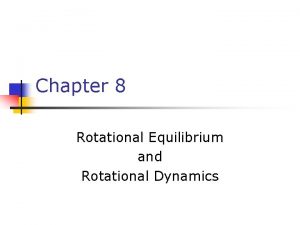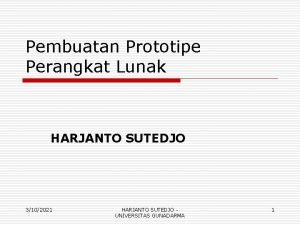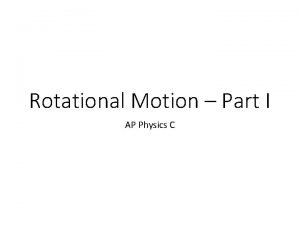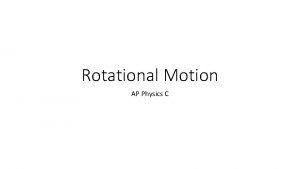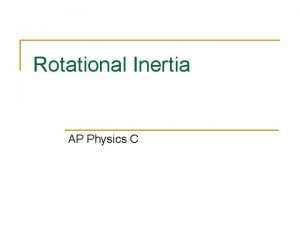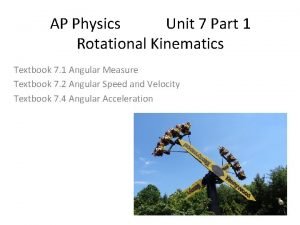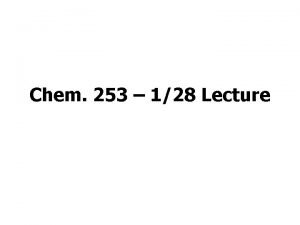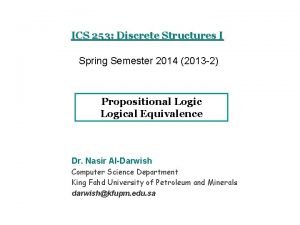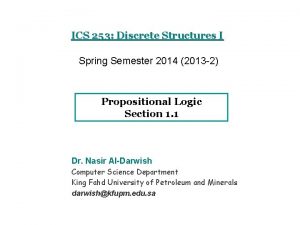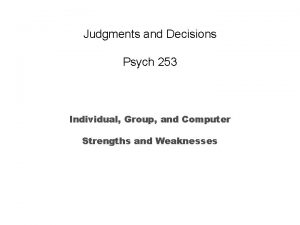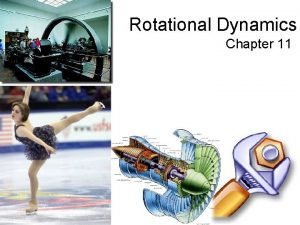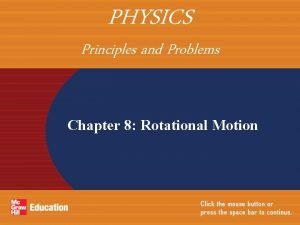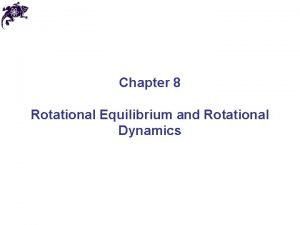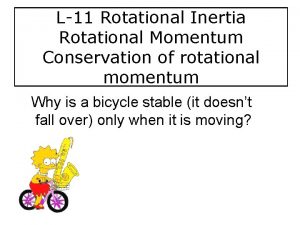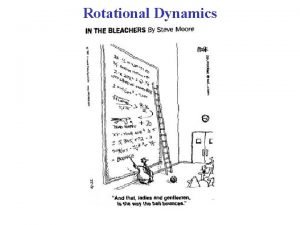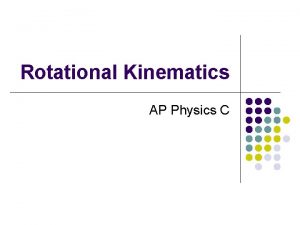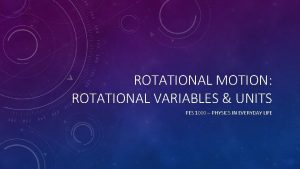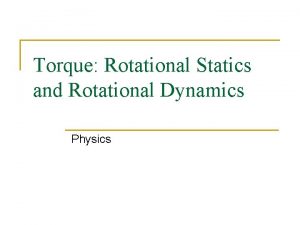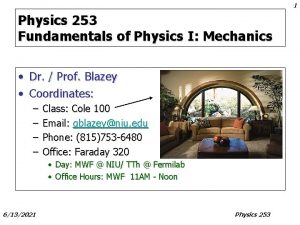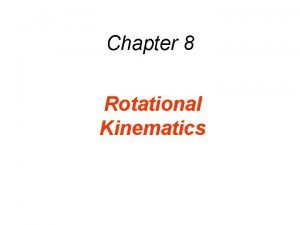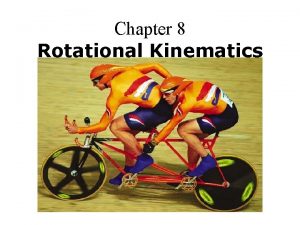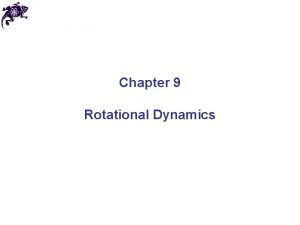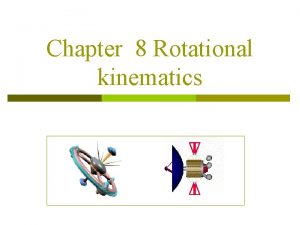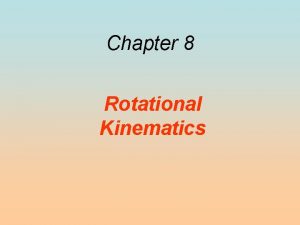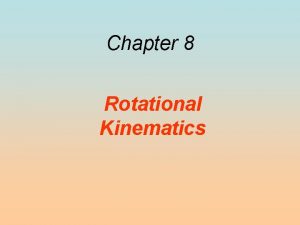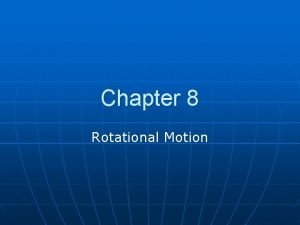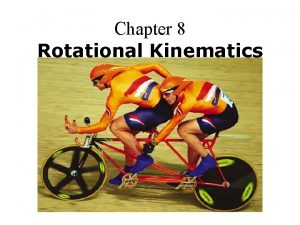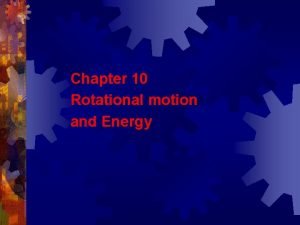1 3102021 Physics 253 2 Chapter 10 Rotational





























- Slides: 29

1 3/10/2021 Physics 253

2 Chapter 10: Rotational Motional About a Fixed Axis ü Review of Angular Quantities & Motion and Torque (10 -1, 10 -2, 10 -3, 10 -5) • Solving Problems in Rotational Dynamics (10 -6, 10 -7) • Determining Moments of Inertia, Conservation of Angular Momentum, and Rotational Kinetic Energy (10 -8, 10 -9, 10 -10) • Rotational + Translational Motion (10 -11, 10 -12) 3/10/2021 Physics 253

3 Review of Quiz 3 • Points – – Total: 50 Average: 35 High: 50 Low: 6 – – – 00 -10: 1 11 -20: 3 21 -30: 22 31 -40: 42 41 -50: 24 • Score Distribution 3/10/2021 Average: 36 Physics 253

4 Problem 1 • Problem 1 (5 points): How much work must be supplied to vertically lift a 10. 0 -kg box 0. 50 meters? a) 2 N b) -98. 0 N c) 4. 9 J d) 49 J • Answer: The force and displacement are in the same direction so W=(F)(d)=(mg)(d)= (10. 0 kg)(9. 8 m/s 2)(0. 50 m)=49 J 3/10/2021 Physics 253

5 Problem 2 • Problem 2 (5 points): The earth’s gravitational potential energy is defined to be zero at: a) the earth’s surface b) infinite distance c) near the moon d) the earth’s center • Answer: 3/10/2021 Physics 253

6 Problem 3 • Problem 3 (5 points): What is the center of mass for m 1 = 5. 0 kg, x 1 = 2. 0 m, m 2 = 12 kg, x 2 = 6. 0 m? a) 82 m b) 4. 8 m c) 8. 5 m d)0. 021 m • Answer: 3/10/2021 Physics 253

7 Problem 4 • Problem 4 (5 points): A spring compressed by 0. 10 m stores 30 J of energy. What is the spring constant? a) 6000 N/m b) 600 N/m c) 300 N/m d) 0. 03 N/m • Answer: 3/10/2021 Physics 253

8 Problem 5 • Problem 5 (5 points): Two astronauts in outer space and initially at rest “push off” and move away from one another. The first astronaut has a mass of 100. 0 kg and a velocity of +2. 5 m/s. If the second astronaut has a velocity of -4. 0 m/s, what is her mass? • Answer: 3/10/2021 Physics 253

9 Problem 6 • Problem 6 (10 points): A motorcyclist is trying to leap across a canyon as shown in the figure. When he leaves the cliff the cycle has a speed of 38. 0 m/s. Using conservation of energy find the speed with which the cycle strikes the ground on the other side. • Answer: 3/10/2021 Physics 253

10 Problem 7 • • Problem 7 (15 points): ): A 5 x 104 kg spaceship is traveling at a speed of 1. 1 x 104 m/s. The engine exerts a force of 4 x 105 N parallel to the displacement and fires until the displacement is 2. 5 x 106 m. (No forces act on the vessel except that generated by its engine. ) Determine (a) the initial kinetic energy, b) the work done by the engine and c) using the Work-Energy Theorem the final velocity of the spaceship. Answer: 3/10/2021 Physics 253

11 Review Torque • Torque = (Lever Arm) x (Magnitude of the force) 3/10/2021 Physics 253

12 Rotational Dynamics: Torque and Rotational Inertia • Just as force is proportional to acceleration, torque seems to be proportional to angular acceleration: • Note that the constant of proportionality for linear motion is mass. Just on dimensional grounds the analogous constant must be different for rotational motion. • Turns out we can get there starting with the 2 nd Law. 3/10/2021 Physics 253

13 • Consider a particle of mass m rotating on a circle of radius r at the end of a massless string or rod and subject to a force F. • The constant of proportionality is m. R 2 and represents the rotational inertia of the particle and is often called the moment of inertia. 3/10/2021 Physics 253

14 3/10/2021 Physics 253

15 Comments on Moment of Inertia • Serves the same role for rotational motion as mass does for linear motion • But since I=Smi. Ri 2 is a sum over many objects it depends on mass distribution – If of equal mass, a larger cylinder will have a greater moment of inertia than a smaller one. Something intuitively true. – When mass is far from the axis, it also hard to rotate something, again something familiar. – For rotational motion the mass of a body cannot be considered as concentrated at the center of mass. • Still it can be extended to the center of mass 3/10/2021 Physics 253

16 Example 1: Moments of Inertia Calculations • Two small weights of mass 5. 0 and 7. 0 kg are mounted 4. 0 m apart on a massless rod. • Calculate the moment of inertia I – About an axis halfway between the weights – About an axis 0. 50 meter to left of the 5. 0 kg mass • Calculate the force on the 7. 0 kg mass needed to achieve an acceleration of 1 rad/sec 2 3/10/2021 Physics 253

17 3/10/2021 Physics 253

18 Characteristics of the Moment of Inertia • Different for different axes. • Masses close to the axis contribute little, but masses distant contribute much. • Calculations can be difficult because the mass distributions are not uniform. • They can be worked out taking the sum to the limit and using calculus: • Experimentally done by measuring a for a known t. 3/10/2021 Physics 253

19 Example 2: A Heavy Pulley A 15. 0 N force is applied to a cord around a 4. 00 kg pulley at a radius of 33. 0 cm. The pulley accelerates uniformly from rest to 30. 0 rad/s in 3. 00 s. If there is a frictional torque at the axel of 1. 10 m. N what is the pulley’s moment of inertia? 3/10/2021 Physics 253

20 3/10/2021 Physics 253

21 3/10/2021 Physics 253

22 3/10/2021 Physics 253

23 Example 3: A Pulley and Bucket • Lets take the heavy pulley problem a bit further and hang a bucket of weight 15. 0 N (m=1. 53 kg) from it. • Calculate – The angular acceleration of the pulley, a, and the linear acceleration of the bucket, a. – If the pulley and bucket start at rest calculate the angular velocity of the pulley, w, and the linear velocity of the bucket, v, at 3. 00 s. 3/10/2021 Physics 253

24 • Our strategy will be to – analyze the rotational motion of the pulley – analyze the linear motion of the bucket – Connect the two and solve for accelerations – Use accelerations to find the final velocity 3/10/2021 Physics 253

25 3/10/2021 Physics 253

26 Example 4: A Rotating Rod • A uniform rod of mass M and length L can pivot freely up or down. The rod is held horizontally and then released. • Assuming the force of gravity acts at the center of mass, at the moment of release determine – The angular acceleration of the rod – The linear acceleration at the tip of the rod. 3/10/2021 Physics 253

27 3/10/2021 Physics 253

28 Solving Problems with Rotational Motion • Draw the free-body diagram! – Show all forces and WHERE they act. – Put gravity at the CG or CM. • Identify the axis of rotation and calculate torques about it. – CCW is positive – CW is negative. • Apply the 2 nd Laws – Rotational motion: St=Ia – Translational motion: SF=ma • Solve the set of equations for any missing info. • Smell test! 3/10/2021 Physics 253

29 To Summarize • Ok we’ve defined torque • This led to the analog of Newton’s 2 nd Law for angular motion: • Where the moment of inertia serves the role of mass • Next we’ll learn how to calculate I and explore angular momentums and rotational energy. 3/10/2021 Physics 253
 Torque right hand rule
Torque right hand rule Second condition of equilibrium
Second condition of equilibrium 3102021
3102021 3102021
3102021 1 inch
1 inch 3102021
3102021 3102021
3102021 3102021
3102021 3102021
3102021 3102021
3102021 Dawn soap commercial
Dawn soap commercial Ap physics rotational motion
Ap physics rotational motion Rolling without slipping meaning
Rolling without slipping meaning Rotational inertia ap physics 1
Rotational inertia ap physics 1 Ap physics unit 7
Ap physics unit 7 National archives gb rail 253/516
National archives gb rail 253/516 Terimaan wang kerajaan
Terimaan wang kerajaan Csc 253
Csc 253 Chem 253
Chem 253 Linear and nonlinear multimedia
Linear and nonlinear multimedia Kibd-253
Kibd-253 Ics 253
Ics 253 Ics 253
Ics 253 En 253
En 253 253 meaning in the bible
253 meaning in the bible Dlpp-261
Dlpp-261 Educational diagnostician (253)
Educational diagnostician (253) Psych 253
Psych 253 Chapter 11 rotational equilibrium
Chapter 11 rotational equilibrium Chapter 8: rotational motion study guide answer key
Chapter 8: rotational motion study guide answer key
